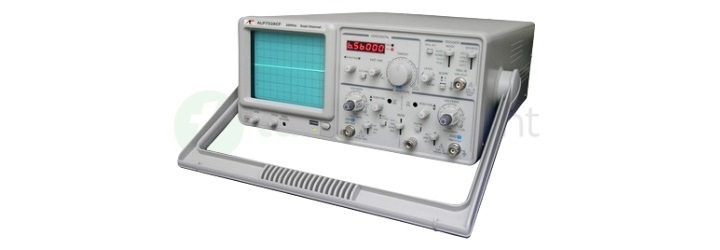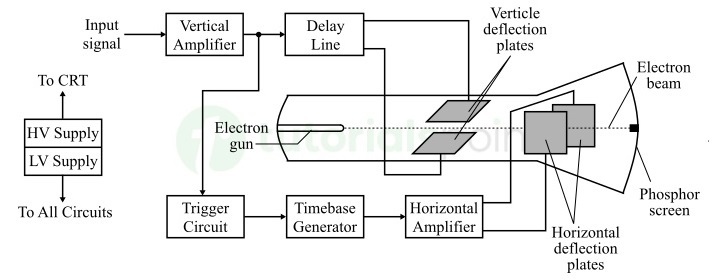
 Data Structure
Data Structure Networking
Networking RDBMS
RDBMS Operating System
Operating System Java
Java MS Excel
MS Excel iOS
iOS HTML
HTML CSS
CSS Android
Android Python
Python C Programming
C Programming C++
C++ C#
C# MongoDB
MongoDB MySQL
MySQL Javascript
Javascript PHP
PHP
- Selected Reading
- UPSC IAS Exams Notes
- Developer's Best Practices
- Questions and Answers
- Effective Resume Writing
- HR Interview Questions
- Computer Glossary
- Who is Who
Cathode Ray Oscilloscope (CRO) and its Applications
Cathode Ray Oscilloscope (CRO) is an electronic device used for testing, research, and design applications. It is a device that helps us to display and analyze the electrical signals in the form of waveforms.
In the field of electrical and electronics engineering, CRO is used to perform numerous operations like frequency measurement, waveform analysis, voltage measurement, amplitude measurement, testing and troubleshooting of electric circuits and systems.
In this article, we will learn about cathode ray oscilloscope (CRO) and its applications. Before that let us discuss the basics of CRO.
What is a CRO?
A CRO is an electronic testing device used for displaying and analyzing electrical signals in the form of their waveforms. It is a cathode ray tube-based instrument. A CRT screen is used in the CRO to display the waveforms of the electric signals.
The following figure depicts a typical CRO.

By using a CRO, we can analyze the following important parameters of the electric signals -
- Amplitude
- Frequency
- Time interval/period, etc.
The Main Components of a CRO
A typical Cathode Ray Oscilloscope (CRO) consists of the following major components -
- Cathode Ray Tube
- Electron Gun
- Fluorescent Screen
- Deflection Plates
- Horizontal and Vertical Amplifiers
- Time Base Generator
- Trigger Circuit
The following schematic diagram shows the interconnection of all these components of a CRO.

Let us understand the function of each of these components of CRO.
Cathode Ray Tube - It is a vacuum tube which acts as the main component in a CRO. The function of CRT in a CRO is to convert the electric signal into visual waveforms.
Electron Gun - It is a part of the cathode ray tube which consists of a heater and two terminals. It is the component that emits the high energy electrons to produce an electron ray. The electron gun is excited by a high voltage supply.
Fluorescent Screen - In CRO, a fluorescent screen is used for displaying waveforms of electric signals measured. This screen is made by using a fluorescent material which emits a light when the high energy electron beam strikes to it.
Deflection Plates - The electron ray coming out from the electron gun passes through the two sets of deflection plates. These plates are referred to as vertical deflection plate and horizontal deflection plate. These plates are used for moving the waveform vertically and horizontally across the screen.
Horizontal and Vertical Amplifiers - These amplifiers are used for amplifying input signals. These amplified signals are then used for deflecting the electron ray vertically and horizontally. The function of these amplifiers is to adjust the scaling and sensitivity of the waveform displayed on the screen.
Time Base Generator - The time base generator is an electronic circuit used for producing a time reference signal for horizontal axis. This time reference signal controls the rate at which the electron ray moves across the CRT screen. In other words, this signal sets the time scale of the waveform of the input electric signal on the screen.
Trigger Circuit - The trigger circuit in a CRO is provided to synchronize the vertical and horizontal deflections of the electron ray. It is important for the stable and clear display of the waveform of the input signal on the screen.
The Working Principle of a CRO
The working of a cathode ray oscilloscope (CRO) depends on the movement of electron beam/ray under the influence of electrostatic forces.
In a CRO, a high voltage signal is applied to the electron gun which produces an electron beam/ray. This electron beam is then made to hit a fluorescent screen to produce a light.
CRO consists of two mutually perpendicular deflecting plates to control the movement of electron beam. The electrostatic forces produced by the deflecting plates control the electron beam and move it to produce a desired waveform of the input electric signal.
Electrical Quantities Measured with CRO
With a CRO, we can measure and analyze the following three main electrical quantities of a signal -
- Amplitude
- Frequency
- Time Period
Let us discuss in detail how we can use a CRO to measure these three electrical quantities.
Measuring the Amplitude using a CRO
The CRO displays an electric signal as a function of time on its screen. The amplitude of this electric signal remains stable; however, we can change the number of partitions covered by the signal in vertical direction by changing the setting of volt/division button on the CRO panel.
Thus, we will get the amplitude of the signal displayed on the CRO screen by using the following formula,
$$\mathrm{A\:=\:j\:\times\:nv}$$
Here, A is the amplitude, j is the value of volt/division, and nv is the number of partitions covered by the signal in vertical direction.
Measuring the Time Period using a CRO
CRO displays the signal waveform as a function of time on its screen. The time period of this input electric signal remains constant. However, we can change the number of divisions covered by the one cycle of signal in the horizontal direction by using the time/division button on the CRO panel.
After doing this, we can calculate the time period of the signal by using the following formula,
$$\mathrm{T\:=\:k\:\times \:nh}$$
Here, T is the time period of the input signal, k is the value of time/division, and nh is the number divisions covered by one cycle of the signal in horizontal direction.
Measuring the Frequency using a CRO
To measure the frequency of an electric signal, firstly we measure its time period. Then, we use the following formula to measure the frequency,
$$\mathrm{f\:=\:\frac{1}{T}}$$
Important Controls of a CRO
To control different parameters of the CRO screen, there are several controls given in the CRO panel. Some of the important controls of a CRO are explained below -
Position - In a CRO, the position control knob is provided to control the position of the intense spot between the left and right sides of the screen.
Brightness - The brightness control button is used for changing the brightness of the electron beam. This control basically changes the intensity of the electron beam.
Focus - This control is used to make the electron beam narrow and make a pin point spot on the screen.
Astigmatism - This control is an additional focus control which is used to produce a sharp focus over the entire screen of the CRO.
Blanking Circuit - This control is used to turn off the electron beam during the retrace period so that the waveform displayed on the screen will appear continuous.
Calibration Circuit - This control of CRO is used for calibration within the oscilloscope. This circuit generates a square waveform which is then used to perform calibration.
Advantages of Using a CRO
Listed below are some of the major advantages of using a CRO that make it a valuable tool in the field of electronics -
- CRO allows us to represent and visualize electric signals in real-time.
- CRO represents electric signals graphically in the form of waveforms, which make their analysis easier.
- CRO is capable of displaying high-frequency electric signals with a high accuracy.
- The electrical and electronic measurements performed using CRO have high accuracy and precision.
- CRO is a versatile device as it can be used to perform various functions like testing, measurement, waveform generation, frequency or time domain analysis of signals, troubleshooting of electric circuits, etc.
- CRO has a human friendly interface, hence it is easy to use.
- CRO has a compact and light weight design which makes it portable.
Disadvantages of Using a CRO
CRO has several advantages as listed above, however it also has certain disadvantages. Some of the common disadvantages of CRO are given below -
- CRO is relatively more expensive as compared to other measuring instruments.
- It is quite tough to repair a CRO if it got damaged.
- As compared to other measuring instruments, CRO has a larger physical size and heavier weight. Hence, it is relatively difficult to carry from one place to another.
- CRO consumes more power than other instruments.
- Since, a CRO has several controls and ports which makes it slightly difficult to understand.
Applications of a CRO
CRO is a versatile device having numerous applications in various fields of electrical, electronics, physics, etc. The following are some key applications of CRO -
- CRO is widely used for repairing and troubleshooting a variety of electrical and electronic circuits.
- It is also used for measuring and analyzing electrical signals.
- CRO can be used to measure the amplitude, time period, frequency, distortion, and phase of electric signals.
- CRO is also employed for time or frequency domain analysis of signals.
- CRO is used for generating different types of waveforms like sinusoidal, square, triangular, or any other type of waveforms.
- In medical systems, CRO can be used for measuring and analyzing physiological signals for diagnosis purpose.
- CRO is also used in radio stations to observe the transmitting and receiving signals.
- It is also used for determine the characteristics of AM or FM circuits.
- In electromagnetism, CRO is used for tracing the BH curves of materials.
Conclusion
In conclusion, a CRO is an electronic instrument used for several applications like measurement, testing, troubleshooting, waveform generation, signal analysis, calibration, etc. In this article, we explained the basics, advantages, disadvantages, working principle, and applications of CRO.

